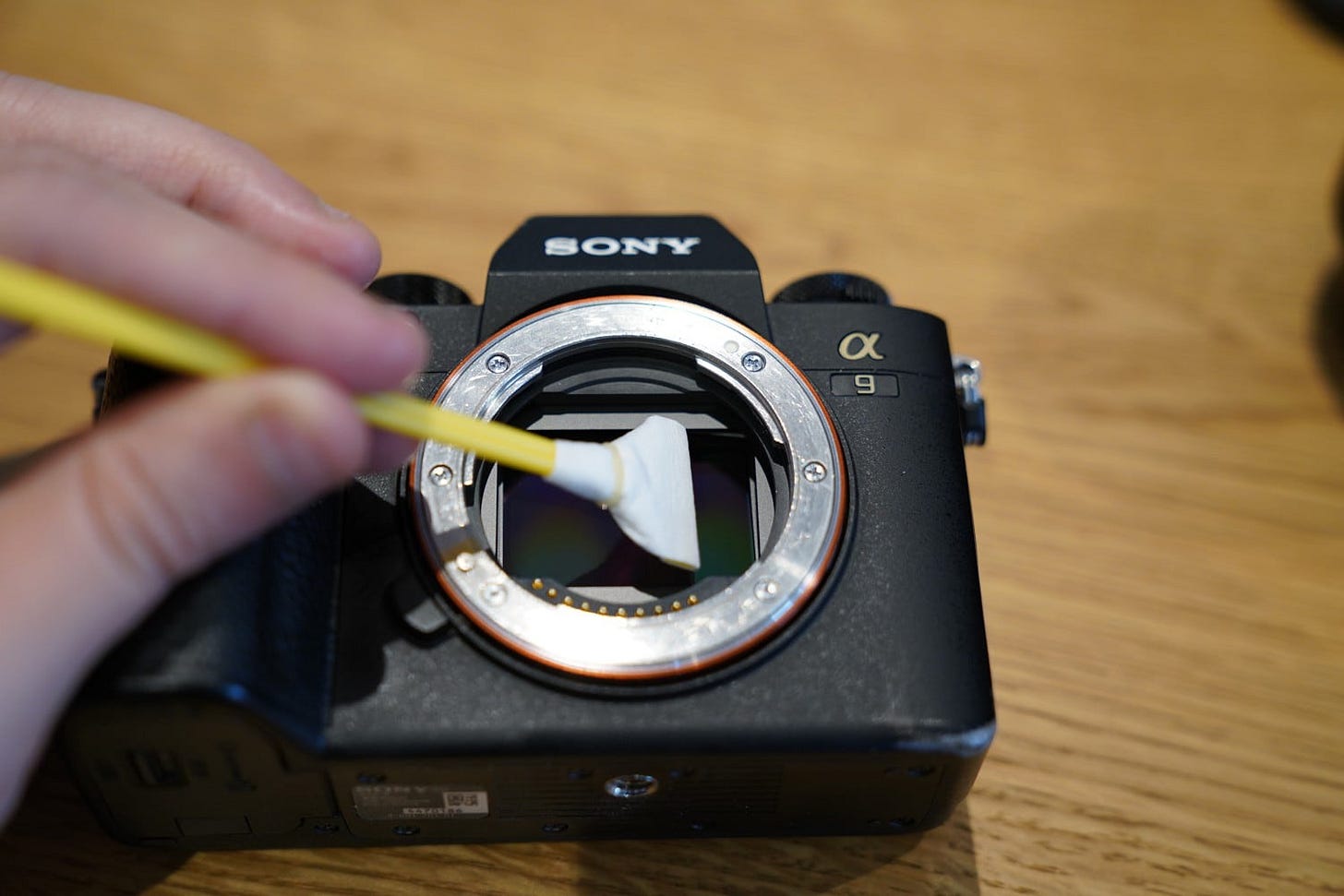Keeping your camera's image sensor clean is key for good photo quality.
Dusty sensors cause ugly spots in your pictures.
But cleaning it wrong can wreck your camera permanently.
Here's how to clean it safely and keep it in top shape:
The Risks of Improper Sensor Cleaning
Your camera's image sensor is super delicate.
Unlike lens parts, it has a thin transparent filter that's easy to scratch.
Using the wrong tools or techniques when cleaning the sensor can lead to several problems:
Scratches or abrasions on the sensor filter will show up as permanent blemishes in your photos.
Introducing dust, lint, or other particles that get trapped inside the camera body
Damaging the sensor's electronic components through improper handling
These types of sensor damage can be very costly to repair, often requiring the entire sensor unit to be replaced.
That's why it's important to follow the proper sensor cleaning procedures.
Never use Q-tips.
They're too rough and can scratch your sensor, leaving smudges or causing permanent harm.
The Right Way to Clean Your Camera Sensor
To safely clean your camera's sensor, you'll need a few specialized tools:
Sensor Cleaning Swabs
These are lint-free, single-use swabs designed specifically for cleaning camera sensors.
They come in different sizes to fit different sensor formats, like the UES APS-C Camera Sensor Cleaning Swabs.
Sensor Cleaning Fluid
A specialized liquid solution formulated to safely clean the sensor without leaving any residue, such as the UES Sensor Cleaning Fluid.
Blower Brush
Use a small hand-held air blower with a soft brush tip to gently remove loose dust and particles, like the Giottos Rocket Air Blower.
Here are a few recommended sensor cleaning kits that include these essential tools:
VSGO Sensor Cleaning Kit for Full-Frame Cameras (Model VS-S03-E)
UES APC-C Camera Sensor Cleaning Kit for DSLR and Mirrorless Cameras
UES APS16 Digital DSLR Reflex and Mirrorless Camera APS-C Sensor Cleaning Kit (14 x 16mm Sensor Cleaning Swabs + 15ml Sensor Cleaner Solution)
The key steps for safely cleaning your camera's sensor are:
Turn off your camera and remove the lens to access the sensor.
Use the blower brush to lightly blow air across the sensor surface, dislodging any loose dust or debris.
Dampen a sensor cleaning swab with just a small drop of the cleaning fluid.
Gently wipe the swab across the sensor in a straight line, applying light pressure. Avoid wiping in a circular motion.
Repeat steps 3-4 with a fresh swab if needed, until the sensor appears clean.
Use the blower brush again to remove any remaining particles.
Replace the lens and power on the camera to check that the sensor is now clean.
Only use products specifically designed for sensor cleaning.
Avoid any tools or materials that could potentially scratch the delicate surface.
Maintaining a Clean Sensor
To keep your camera's sensor as clean as possible between deep cleanings, there are a few best practices to follow:
Change lenses in a clean, dust-free environment whenever possible.
Use the camera's built-in sensor cleaning function regularly.
Store your camera with the lens mount facing down to prevent dust from settling on the sensor.
Consider using a sensor cleaning brush or blower after every lens change.
Cleaning the Camera's Viewfinder
It's also important to keep the camera's viewfinder clean.
This is the part you look through to see what you're taking a picture of.
It gets dirty easily from oils, sweat, and gunk from your face.
To clean the viewfinder safely, follow these steps:
Use a brush or compressed air to blow away any loose dirt or dust.
Dampen a clean microfiber cloth with a lens cleaning solution or rubbing alcohol (70% or higher).
Gently wipe the viewfinder surface with the damp cloth in a circular motion to remove smudges or oils.
Use a dry part of the cloth to wipe away any moisture left behind.
Optionally, you can use a special lens cleaning pen or brush made for viewfinders to polish it up.
Avoid using household cleaners, soap, or water as they can leave streaks.
Never touch the viewfinder directly with your fingers either, as the oils will make it harder to clean.
Keeping both the camera sensor and viewfinder clean will give you the best image quality and make it more comfortable to use.
It also reduces the risk of getting an eye infection.
And That’s It
With the right tools and techniques, you can safely maintain a spotless sensor and ensure the highest image quality from your camera.
Just be sure to take the necessary precautions to avoid any accidental damage.
I hope that helps.
-Hakan.





